Financial Management, Statements, and Ratios: BMP3005 Finance Report
VerifiedAdded on 2023/06/15
|14
|2531
|290
Report
AI Summary
This report provides a comprehensive analysis of financial management, emphasizing its importance and various processes for improving financial performance. It defines financial management and discusses key financial statements, including the balance sheet, income statement, and cash flow statement, along with the application of ratio analysis. The report includes a practical section using a provided template to complete a business review, generate an income statement and balance sheet in Excel, and describe the company's profitability, liquidity, and efficiency based on ratio analysis results. Furthermore, it uses examples from a case study to explore processes businesses can implement to enhance their financial performance, such as debt consolidation, maintaining positive income, minimizing overhead expenses, seeking professional help, and liquidating resources. The conclusion reinforces the significance of financial management and accurate financial statement interpretation for achieving productivity and long-term business success. Desklib offers a wealth of similar solved assignments and resources for students.
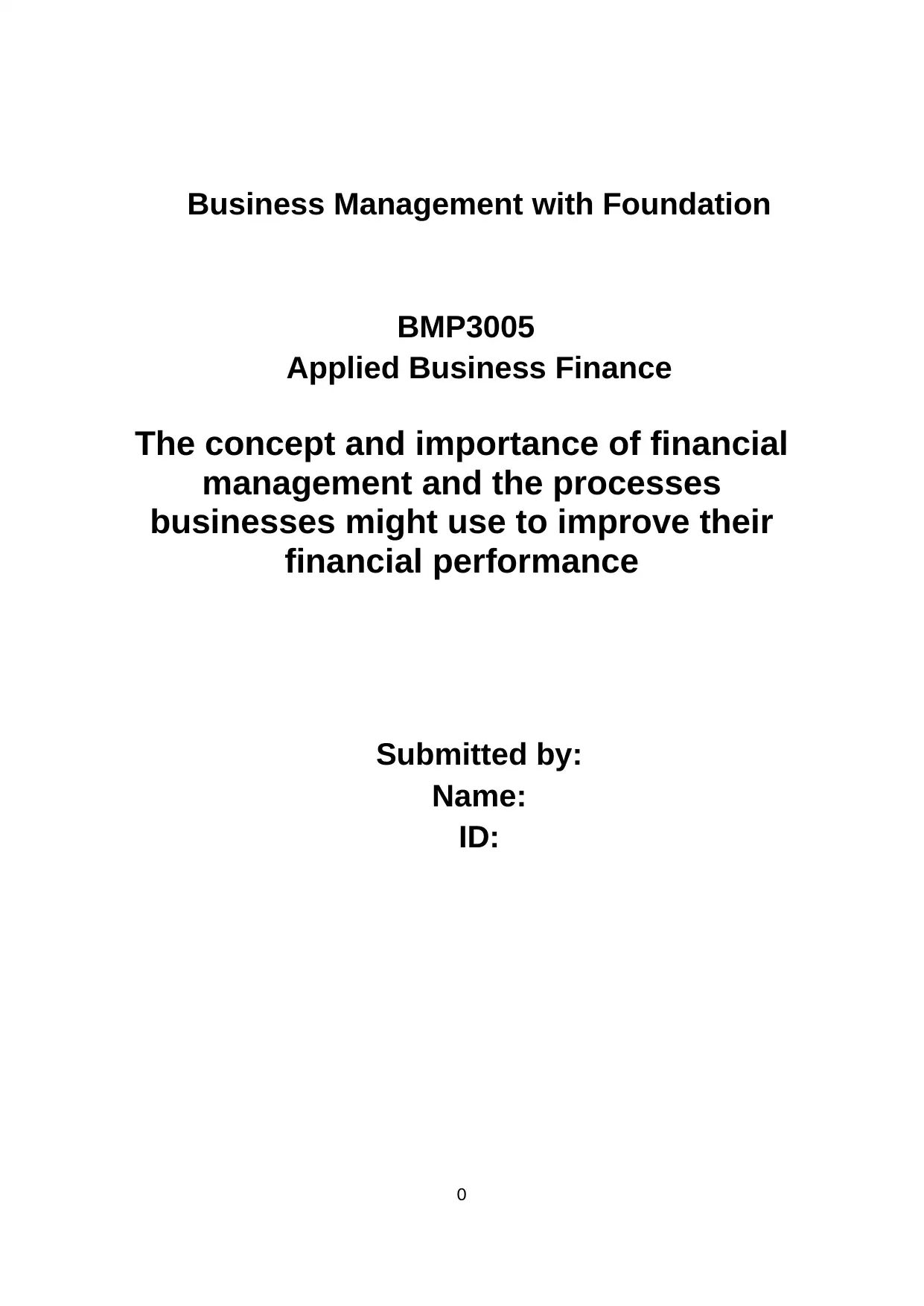
Business Management with Foundation
BMP3005
Applied Business Finance
The concept and importance of financial
management and the processes
businesses might use to improve their
financial performance
Submitted by:
Name:
ID:
0
BMP3005
Applied Business Finance
The concept and importance of financial
management and the processes
businesses might use to improve their
financial performance
Submitted by:
Name:
ID:
0
Paraphrase This Document
Need a fresh take? Get an instant paraphrase of this document with our AI Paraphraser
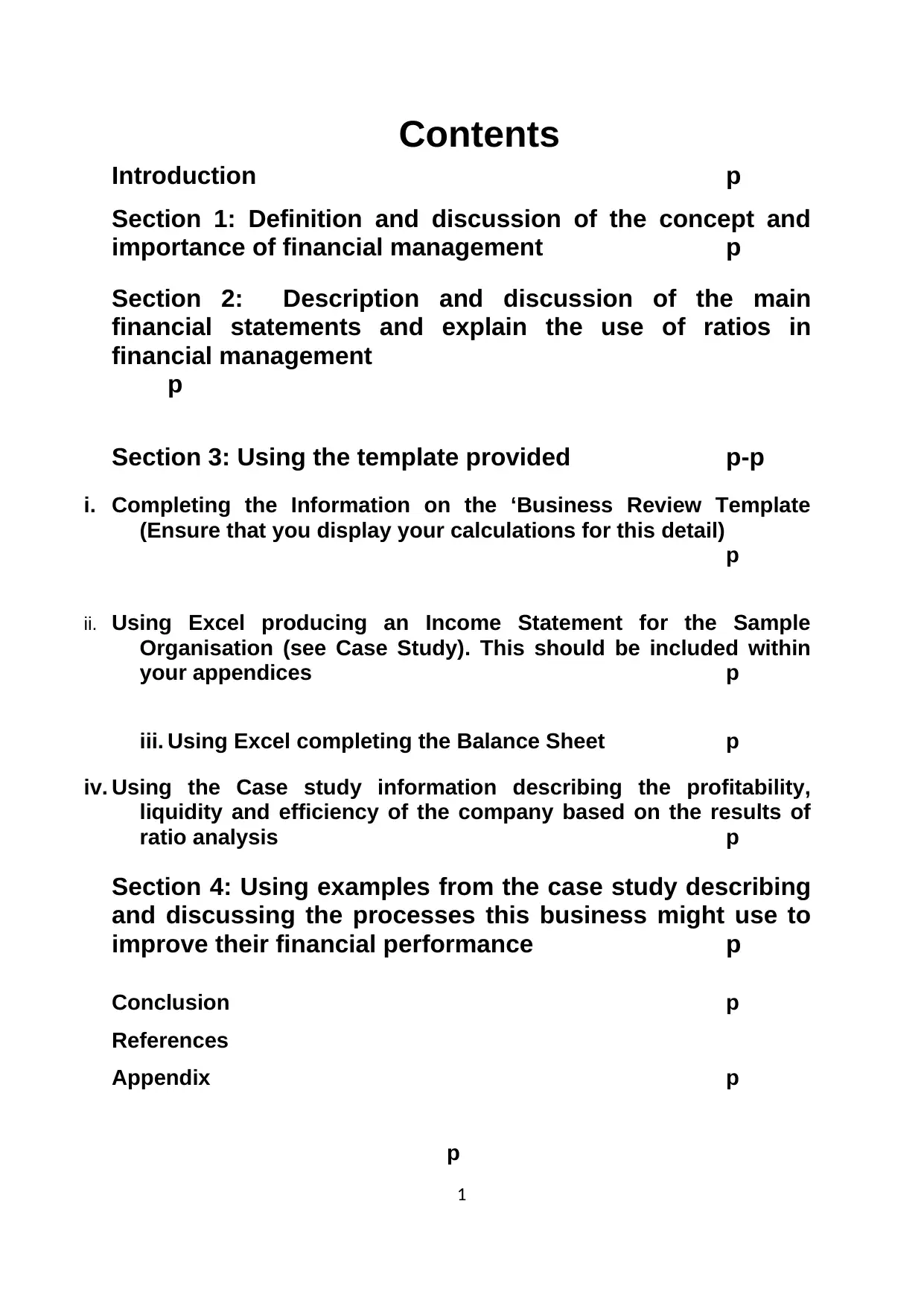
Contents
Introduction p
Section 1: Definition and discussion of the concept and
importance of financial management p
Section 2: Description and discussion of the main
financial statements and explain the use of ratios in
financial management
p
Section 3: Using the template provided p-p
i. Completing the Information on the ‘Business Review Template
(Ensure that you display your calculations for this detail)
p
ii. Using Excel producing an Income Statement for the Sample
Organisation (see Case Study). This should be included within
your appendices p
iii. Using Excel completing the Balance Sheet p
iv. Using the Case study information describing the profitability,
liquidity and efficiency of the company based on the results of
ratio analysis p
Section 4: Using examples from the case study describing
and discussing the processes this business might use to
improve their financial performance p
Conclusion p
References
Appendix p
p
1
Introduction p
Section 1: Definition and discussion of the concept and
importance of financial management p
Section 2: Description and discussion of the main
financial statements and explain the use of ratios in
financial management
p
Section 3: Using the template provided p-p
i. Completing the Information on the ‘Business Review Template
(Ensure that you display your calculations for this detail)
p
ii. Using Excel producing an Income Statement for the Sample
Organisation (see Case Study). This should be included within
your appendices p
iii. Using Excel completing the Balance Sheet p
iv. Using the Case study information describing the profitability,
liquidity and efficiency of the company based on the results of
ratio analysis p
Section 4: Using examples from the case study describing
and discussing the processes this business might use to
improve their financial performance p
Conclusion p
References
Appendix p
p
1
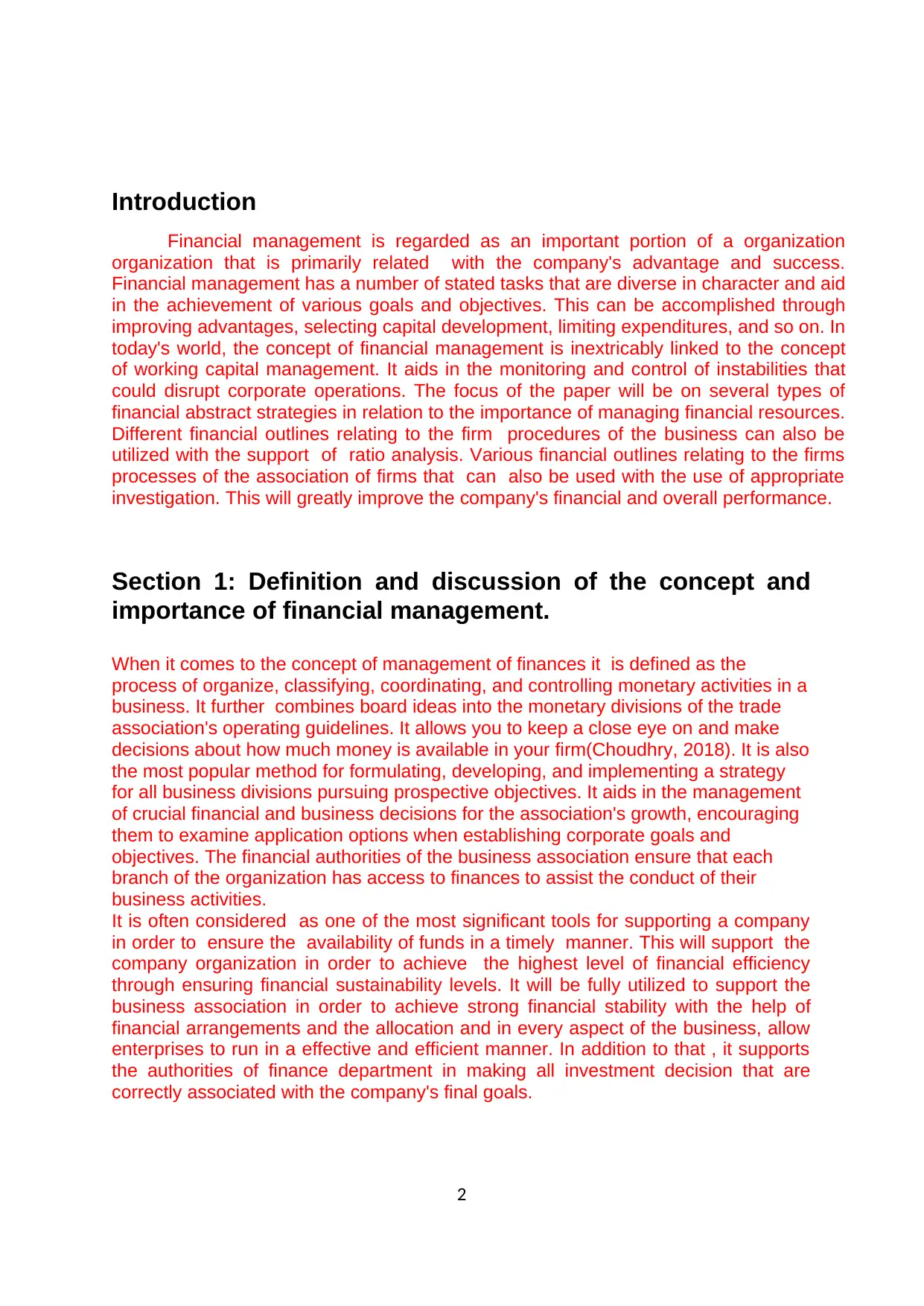
Introduction
Financial management is regarded as an important portion of a organization
organization that is primarily related with the company's advantage and success.
Financial management has a number of stated tasks that are diverse in character and aid
in the achievement of various goals and objectives. This can be accomplished through
improving advantages, selecting capital development, limiting expenditures, and so on. In
today's world, the concept of financial management is inextricably linked to the concept
of working capital management. It aids in the monitoring and control of instabilities that
could disrupt corporate operations. The focus of the paper will be on several types of
financial abstract strategies in relation to the importance of managing financial resources.
Different financial outlines relating to the firm procedures of the business can also be
utilized with the support of ratio analysis. Various financial outlines relating to the firms
processes of the association of firms that can also be used with the use of appropriate
investigation. This will greatly improve the company's financial and overall performance.
Section 1: Definition and discussion of the concept and
importance of financial management.
When it comes to the concept of management of finances it is defined as the
process of organize, classifying, coordinating, and controlling monetary activities in a
business. It further combines board ideas into the monetary divisions of the trade
association's operating guidelines. It allows you to keep a close eye on and make
decisions about how much money is available in your firm(Choudhry, 2018). It is also
the most popular method for formulating, developing, and implementing a strategy
for all business divisions pursuing prospective objectives. It aids in the management
of crucial financial and business decisions for the association's growth, encouraging
them to examine application options when establishing corporate goals and
objectives. The financial authorities of the business association ensure that each
branch of the organization has access to finances to assist the conduct of their
business activities.
It is often considered as one of the most significant tools for supporting a company
in order to ensure the availability of funds in a timely manner. This will support the
company organization in order to achieve the highest level of financial efficiency
through ensuring financial sustainability levels. It will be fully utilized to support the
business association in order to achieve strong financial stability with the help of
financial arrangements and the allocation and in every aspect of the business, allow
enterprises to run in a effective and efficient manner. In addition to that , it supports
the authorities of finance department in making all investment decision that are
correctly associated with the company's final goals.
2
Financial management is regarded as an important portion of a organization
organization that is primarily related with the company's advantage and success.
Financial management has a number of stated tasks that are diverse in character and aid
in the achievement of various goals and objectives. This can be accomplished through
improving advantages, selecting capital development, limiting expenditures, and so on. In
today's world, the concept of financial management is inextricably linked to the concept
of working capital management. It aids in the monitoring and control of instabilities that
could disrupt corporate operations. The focus of the paper will be on several types of
financial abstract strategies in relation to the importance of managing financial resources.
Different financial outlines relating to the firm procedures of the business can also be
utilized with the support of ratio analysis. Various financial outlines relating to the firms
processes of the association of firms that can also be used with the use of appropriate
investigation. This will greatly improve the company's financial and overall performance.
Section 1: Definition and discussion of the concept and
importance of financial management.
When it comes to the concept of management of finances it is defined as the
process of organize, classifying, coordinating, and controlling monetary activities in a
business. It further combines board ideas into the monetary divisions of the trade
association's operating guidelines. It allows you to keep a close eye on and make
decisions about how much money is available in your firm(Choudhry, 2018). It is also
the most popular method for formulating, developing, and implementing a strategy
for all business divisions pursuing prospective objectives. It aids in the management
of crucial financial and business decisions for the association's growth, encouraging
them to examine application options when establishing corporate goals and
objectives. The financial authorities of the business association ensure that each
branch of the organization has access to finances to assist the conduct of their
business activities.
It is often considered as one of the most significant tools for supporting a company
in order to ensure the availability of funds in a timely manner. This will support the
company organization in order to achieve the highest level of financial efficiency
through ensuring financial sustainability levels. It will be fully utilized to support the
business association in order to achieve strong financial stability with the help of
financial arrangements and the allocation and in every aspect of the business, allow
enterprises to run in a effective and efficient manner. In addition to that , it supports
the authorities of finance department in making all investment decision that are
correctly associated with the company's final goals.
2
⊘ This is a preview!⊘
Do you want full access?
Subscribe today to unlock all pages.

Trusted by 1+ million students worldwide
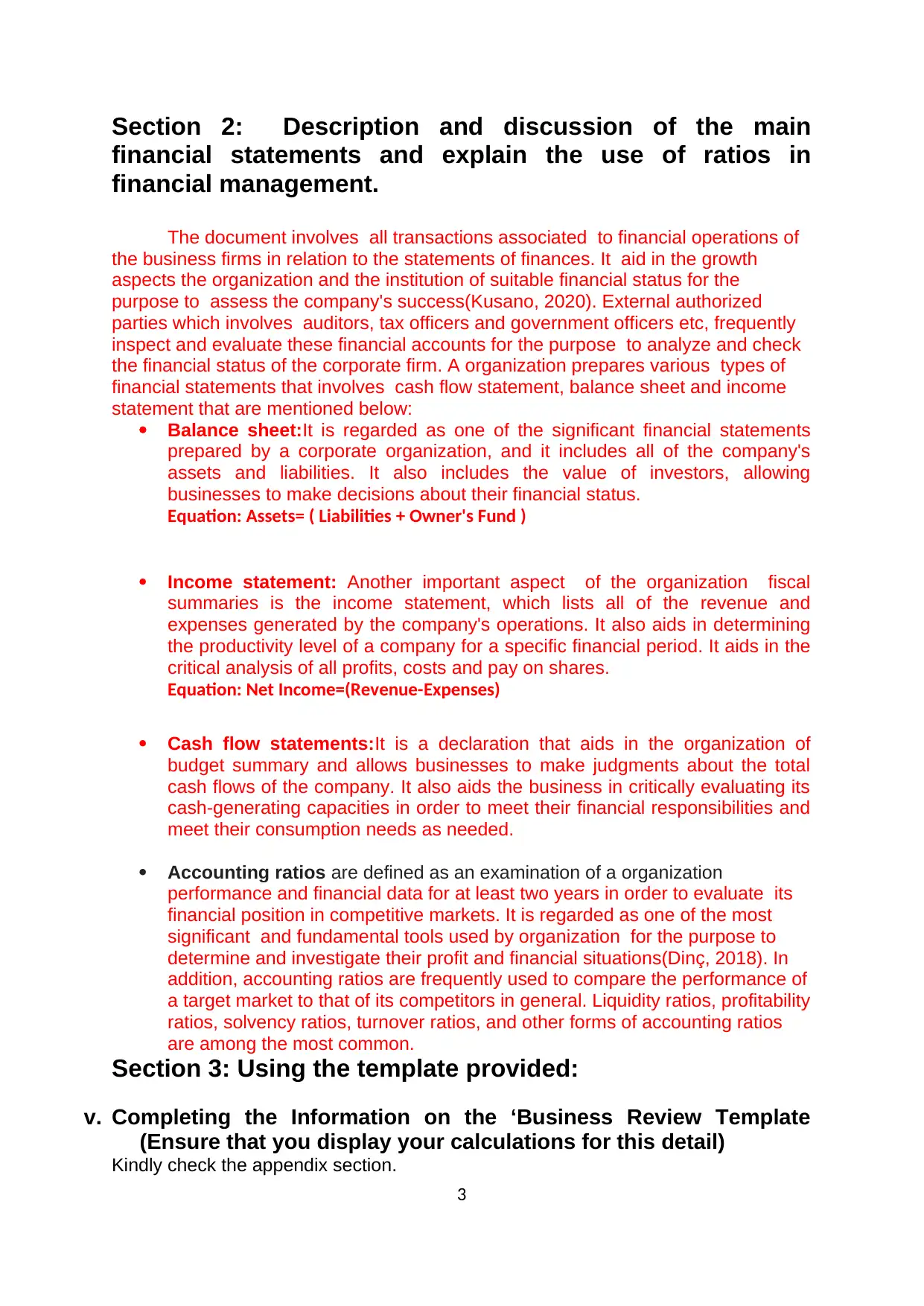
Section 2: Description and discussion of the main
financial statements and explain the use of ratios in
financial management.
The document involves all transactions associated to financial operations of
the business firms in relation to the statements of finances. It aid in the growth
aspects the organization and the institution of suitable financial status for the
purpose to assess the company's success(Kusano, 2020). External authorized
parties which involves auditors, tax officers and government officers etc, frequently
inspect and evaluate these financial accounts for the purpose to analyze and check
the financial status of the corporate firm. A organization prepares various types of
financial statements that involves cash flow statement, balance sheet and income
statement that are mentioned below:
Balance sheet:It is regarded as one of the significant financial statements
prepared by a corporate organization, and it includes all of the company's
assets and liabilities. It also includes the value of investors, allowing
businesses to make decisions about their financial status.
Equation: Assets= ( Liabilities + Owner's Fund )
Income statement: Another important aspect of the organization fiscal
summaries is the income statement, which lists all of the revenue and
expenses generated by the company's operations. It also aids in determining
the productivity level of a company for a specific financial period. It aids in the
critical analysis of all profits, costs and pay on shares.
Equation: Net Income=(Revenue-Expenses)
Cash flow statements:It is a declaration that aids in the organization of
budget summary and allows businesses to make judgments about the total
cash flows of the company. It also aids the business in critically evaluating its
cash-generating capacities in order to meet their financial responsibilities and
meet their consumption needs as needed.
Accounting ratios are defined as an examination of a organization
performance and financial data for at least two years in order to evaluate its
financial position in competitive markets. It is regarded as one of the most
significant and fundamental tools used by organization for the purpose to
determine and investigate their profit and financial situations(Dinç, 2018). In
addition, accounting ratios are frequently used to compare the performance of
a target market to that of its competitors in general. Liquidity ratios, profitability
ratios, solvency ratios, turnover ratios, and other forms of accounting ratios
are among the most common.
Section 3: Using the template provided:
v. Completing the Information on the ‘Business Review Template
(Ensure that you display your calculations for this detail)
Kindly check the appendix section.
3
financial statements and explain the use of ratios in
financial management.
The document involves all transactions associated to financial operations of
the business firms in relation to the statements of finances. It aid in the growth
aspects the organization and the institution of suitable financial status for the
purpose to assess the company's success(Kusano, 2020). External authorized
parties which involves auditors, tax officers and government officers etc, frequently
inspect and evaluate these financial accounts for the purpose to analyze and check
the financial status of the corporate firm. A organization prepares various types of
financial statements that involves cash flow statement, balance sheet and income
statement that are mentioned below:
Balance sheet:It is regarded as one of the significant financial statements
prepared by a corporate organization, and it includes all of the company's
assets and liabilities. It also includes the value of investors, allowing
businesses to make decisions about their financial status.
Equation: Assets= ( Liabilities + Owner's Fund )
Income statement: Another important aspect of the organization fiscal
summaries is the income statement, which lists all of the revenue and
expenses generated by the company's operations. It also aids in determining
the productivity level of a company for a specific financial period. It aids in the
critical analysis of all profits, costs and pay on shares.
Equation: Net Income=(Revenue-Expenses)
Cash flow statements:It is a declaration that aids in the organization of
budget summary and allows businesses to make judgments about the total
cash flows of the company. It also aids the business in critically evaluating its
cash-generating capacities in order to meet their financial responsibilities and
meet their consumption needs as needed.
Accounting ratios are defined as an examination of a organization
performance and financial data for at least two years in order to evaluate its
financial position in competitive markets. It is regarded as one of the most
significant and fundamental tools used by organization for the purpose to
determine and investigate their profit and financial situations(Dinç, 2018). In
addition, accounting ratios are frequently used to compare the performance of
a target market to that of its competitors in general. Liquidity ratios, profitability
ratios, solvency ratios, turnover ratios, and other forms of accounting ratios
are among the most common.
Section 3: Using the template provided:
v. Completing the Information on the ‘Business Review Template
(Ensure that you display your calculations for this detail)
Kindly check the appendix section.
3
Paraphrase This Document
Need a fresh take? Get an instant paraphrase of this document with our AI Paraphraser
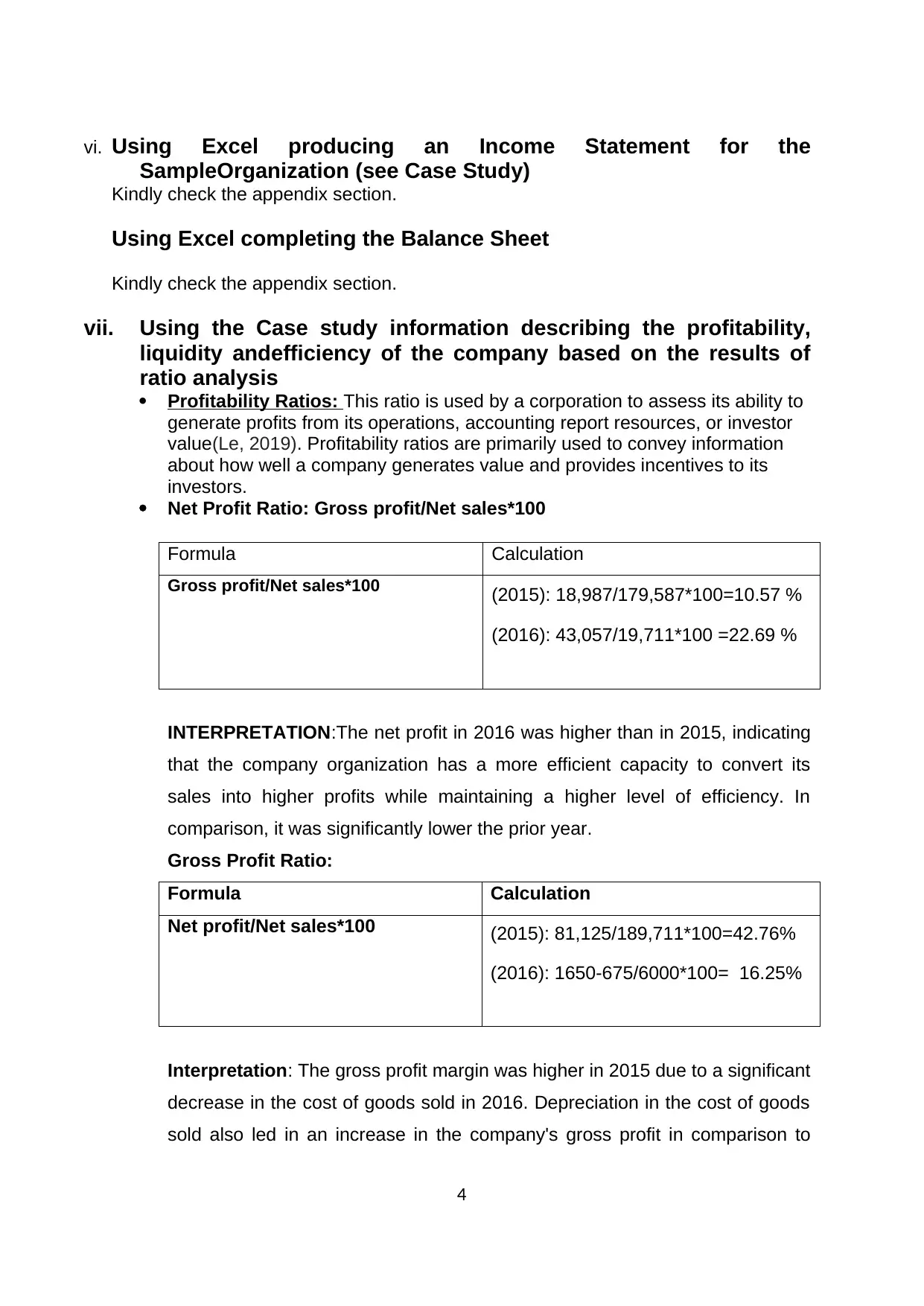
vi. Using Excel producing an Income Statement for the
SampleOrganization (see Case Study)
Kindly check the appendix section.
Using Excel completing the Balance Sheet
Kindly check the appendix section.
vii. Using the Case study information describing the profitability,
liquidity andefficiency of the company based on the results of
ratio analysis
Profitability Ratios: This ratio is used by a corporation to assess its ability to
generate profits from its operations, accounting report resources, or investor
value(Le, 2019). Profitability ratios are primarily used to convey information
about how well a company generates value and provides incentives to its
investors.
Net Profit Ratio: Gross profit/Net sales*100
Formula Calculation
Gross profit/Net sales*100 (2015): 18,987/179,587*100=10.57 %
(2016): 43,057/19,711*100 =22.69 %
INTERPRETATION:The net profit in 2016 was higher than in 2015, indicating
that the company organization has a more efficient capacity to convert its
sales into higher profits while maintaining a higher level of efficiency. In
comparison, it was significantly lower the prior year.
Gross Profit Ratio:
Formula Calculation
Net profit/Net sales*100 (2015): 81,125/189,711*100=42.76%
(2016): 1650-675/6000*100= 16.25%
Interpretation: The gross profit margin was higher in 2015 due to a significant
decrease in the cost of goods sold in 2016. Depreciation in the cost of goods
sold also led in an increase in the company's gross profit in comparison to
4
SampleOrganization (see Case Study)
Kindly check the appendix section.
Using Excel completing the Balance Sheet
Kindly check the appendix section.
vii. Using the Case study information describing the profitability,
liquidity andefficiency of the company based on the results of
ratio analysis
Profitability Ratios: This ratio is used by a corporation to assess its ability to
generate profits from its operations, accounting report resources, or investor
value(Le, 2019). Profitability ratios are primarily used to convey information
about how well a company generates value and provides incentives to its
investors.
Net Profit Ratio: Gross profit/Net sales*100
Formula Calculation
Gross profit/Net sales*100 (2015): 18,987/179,587*100=10.57 %
(2016): 43,057/19,711*100 =22.69 %
INTERPRETATION:The net profit in 2016 was higher than in 2015, indicating
that the company organization has a more efficient capacity to convert its
sales into higher profits while maintaining a higher level of efficiency. In
comparison, it was significantly lower the prior year.
Gross Profit Ratio:
Formula Calculation
Net profit/Net sales*100 (2015): 81,125/189,711*100=42.76%
(2016): 1650-675/6000*100= 16.25%
Interpretation: The gross profit margin was higher in 2015 due to a significant
decrease in the cost of goods sold in 2016. Depreciation in the cost of goods
sold also led in an increase in the company's gross profit in comparison to
4
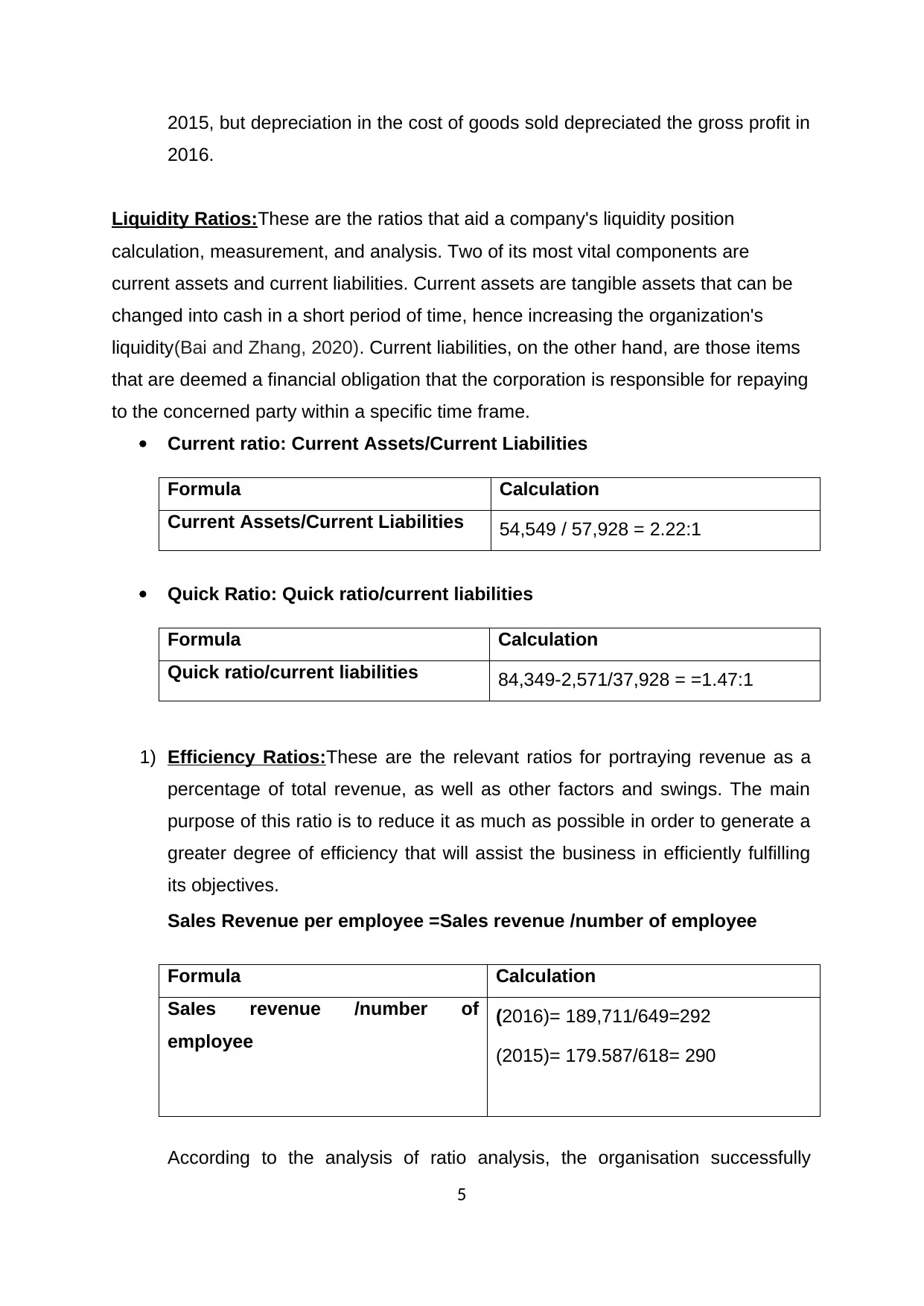
2015, but depreciation in the cost of goods sold depreciated the gross profit in
2016.
Liquidity Ratios:These are the ratios that aid a company's liquidity position
calculation, measurement, and analysis. Two of its most vital components are
current assets and current liabilities. Current assets are tangible assets that can be
changed into cash in a short period of time, hence increasing the organization's
liquidity(Bai and Zhang, 2020). Current liabilities, on the other hand, are those items
that are deemed a financial obligation that the corporation is responsible for repaying
to the concerned party within a specific time frame.
Current ratio: Current Assets/Current Liabilities
Formula Calculation
Current Assets/Current Liabilities 54,549 / 57,928 = 2.22:1
Quick Ratio: Quick ratio/current liabilities
Formula Calculation
Quick ratio/current liabilities 84,349-2,571/37,928 = =1.47:1
1) Efficiency Ratios:These are the relevant ratios for portraying revenue as a
percentage of total revenue, as well as other factors and swings. The main
purpose of this ratio is to reduce it as much as possible in order to generate a
greater degree of efficiency that will assist the business in efficiently fulfilling
its objectives.
Sales Revenue per employee =SaIes revenue /number of employee
Formula Calculation
SaIes revenue /number of
employee
(2016)= 189,711/649=292
(2015)= 179.587/618= 290
According to the analysis of ratio analysis, the organisation successfully
5
2016.
Liquidity Ratios:These are the ratios that aid a company's liquidity position
calculation, measurement, and analysis. Two of its most vital components are
current assets and current liabilities. Current assets are tangible assets that can be
changed into cash in a short period of time, hence increasing the organization's
liquidity(Bai and Zhang, 2020). Current liabilities, on the other hand, are those items
that are deemed a financial obligation that the corporation is responsible for repaying
to the concerned party within a specific time frame.
Current ratio: Current Assets/Current Liabilities
Formula Calculation
Current Assets/Current Liabilities 54,549 / 57,928 = 2.22:1
Quick Ratio: Quick ratio/current liabilities
Formula Calculation
Quick ratio/current liabilities 84,349-2,571/37,928 = =1.47:1
1) Efficiency Ratios:These are the relevant ratios for portraying revenue as a
percentage of total revenue, as well as other factors and swings. The main
purpose of this ratio is to reduce it as much as possible in order to generate a
greater degree of efficiency that will assist the business in efficiently fulfilling
its objectives.
Sales Revenue per employee =SaIes revenue /number of employee
Formula Calculation
SaIes revenue /number of
employee
(2016)= 189,711/649=292
(2015)= 179.587/618= 290
According to the analysis of ratio analysis, the organisation successfully
5
⊘ This is a preview!⊘
Do you want full access?
Subscribe today to unlock all pages.

Trusted by 1+ million students worldwide
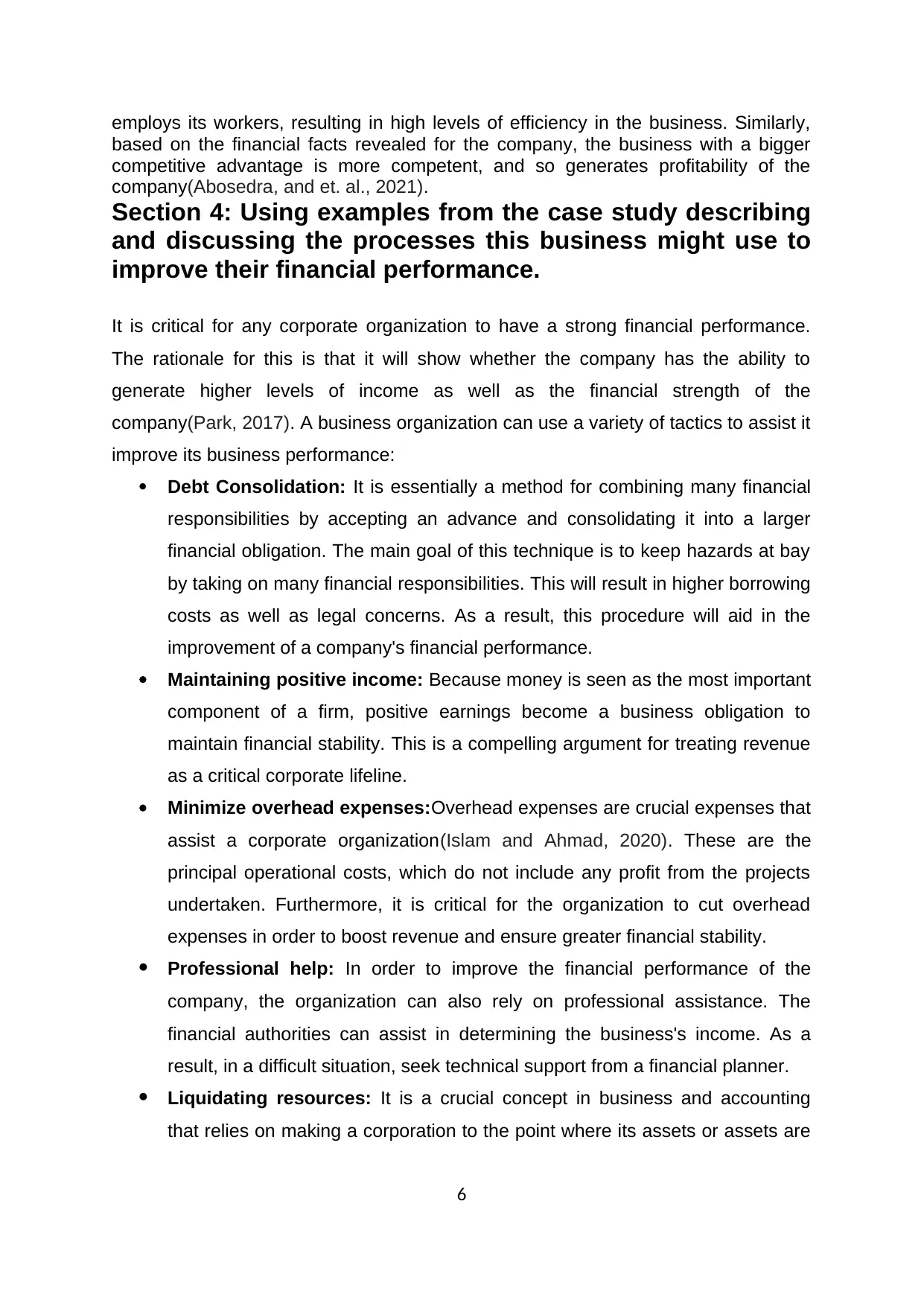
employs its workers, resulting in high levels of efficiency in the business. Similarly,
based on the financial facts revealed for the company, the business with a bigger
competitive advantage is more competent, and so generates profitability of the
company(Abosedra, and et. al., 2021).
Section 4: Using examples from the case study describing
and discussing the processes this business might use to
improve their financial performance.
It is critical for any corporate organization to have a strong financial performance.
The rationale for this is that it will show whether the company has the ability to
generate higher levels of income as well as the financial strength of the
company(Park, 2017). A business organization can use a variety of tactics to assist it
improve its business performance:
Debt Consolidation: It is essentially a method for combining many financial
responsibilities by accepting an advance and consolidating it into a larger
financial obligation. The main goal of this technique is to keep hazards at bay
by taking on many financial responsibilities. This will result in higher borrowing
costs as well as legal concerns. As a result, this procedure will aid in the
improvement of a company's financial performance.
Maintaining positive income: Because money is seen as the most important
component of a firm, positive earnings become a business obligation to
maintain financial stability. This is a compelling argument for treating revenue
as a critical corporate lifeline.
Minimize overhead expenses:Overhead expenses are crucial expenses that
assist a corporate organization(Islam and Ahmad, 2020). These are the
principal operational costs, which do not include any profit from the projects
undertaken. Furthermore, it is critical for the organization to cut overhead
expenses in order to boost revenue and ensure greater financial stability.
Professional help: In order to improve the financial performance of the
company, the organization can also rely on professional assistance. The
financial authorities can assist in determining the business's income. As a
result, in a difficult situation, seek technical support from a financial planner.
Liquidating resources: It is a crucial concept in business and accounting
that relies on making a corporation to the point where its assets or assets are
6
based on the financial facts revealed for the company, the business with a bigger
competitive advantage is more competent, and so generates profitability of the
company(Abosedra, and et. al., 2021).
Section 4: Using examples from the case study describing
and discussing the processes this business might use to
improve their financial performance.
It is critical for any corporate organization to have a strong financial performance.
The rationale for this is that it will show whether the company has the ability to
generate higher levels of income as well as the financial strength of the
company(Park, 2017). A business organization can use a variety of tactics to assist it
improve its business performance:
Debt Consolidation: It is essentially a method for combining many financial
responsibilities by accepting an advance and consolidating it into a larger
financial obligation. The main goal of this technique is to keep hazards at bay
by taking on many financial responsibilities. This will result in higher borrowing
costs as well as legal concerns. As a result, this procedure will aid in the
improvement of a company's financial performance.
Maintaining positive income: Because money is seen as the most important
component of a firm, positive earnings become a business obligation to
maintain financial stability. This is a compelling argument for treating revenue
as a critical corporate lifeline.
Minimize overhead expenses:Overhead expenses are crucial expenses that
assist a corporate organization(Islam and Ahmad, 2020). These are the
principal operational costs, which do not include any profit from the projects
undertaken. Furthermore, it is critical for the organization to cut overhead
expenses in order to boost revenue and ensure greater financial stability.
Professional help: In order to improve the financial performance of the
company, the organization can also rely on professional assistance. The
financial authorities can assist in determining the business's income. As a
result, in a difficult situation, seek technical support from a financial planner.
Liquidating resources: It is a crucial concept in business and accounting
that relies on making a corporation to the point where its assets or assets are
6
Paraphrase This Document
Need a fresh take? Get an instant paraphrase of this document with our AI Paraphraser

disposed off. As a result, the firm's general parties are reported to be in
liquidation(Guth and Sachs, 2018).
7
liquidation(Guth and Sachs, 2018).
7
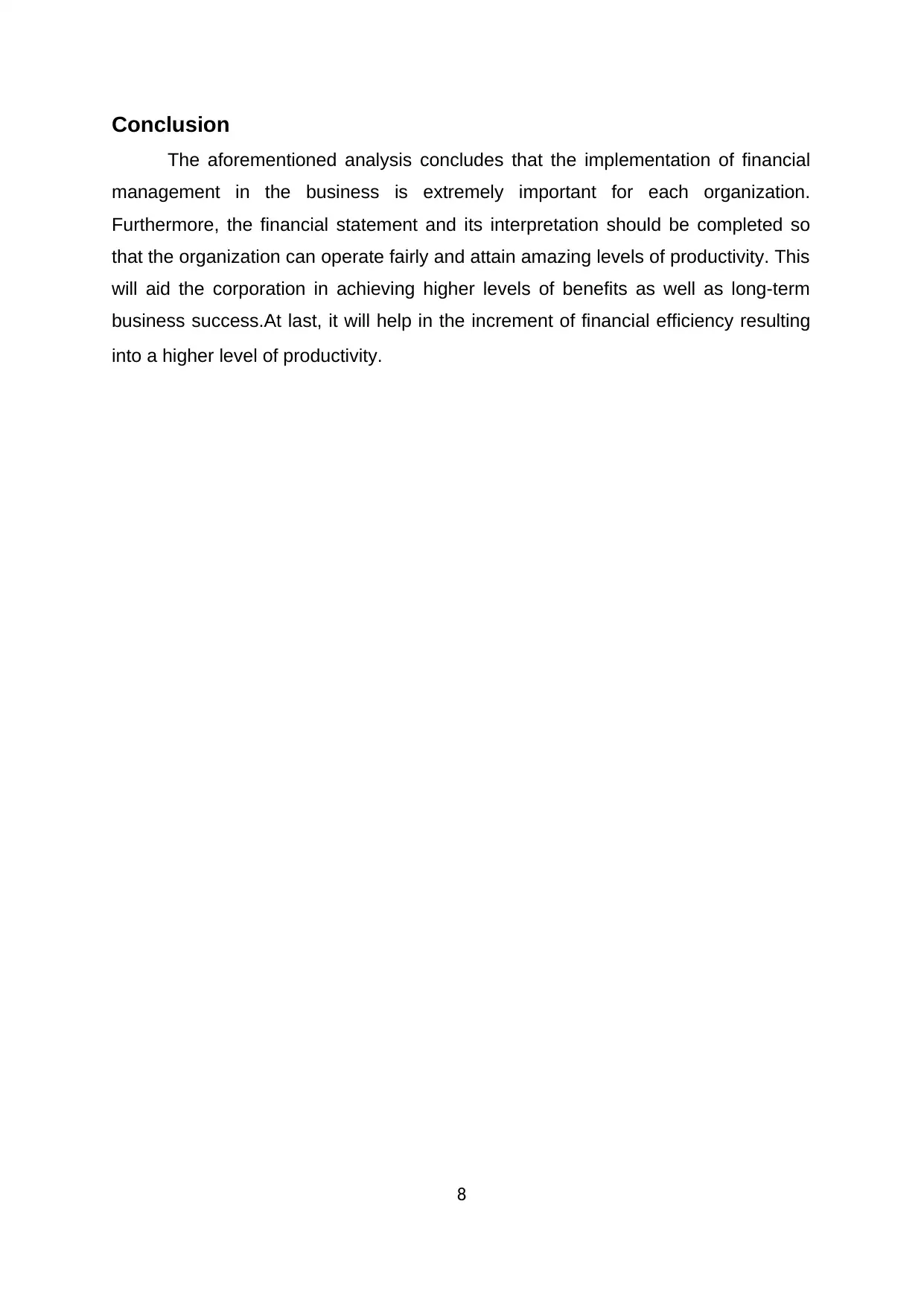
Conclusion
The aforementioned analysis concludes that the implementation of financial
management in the business is extremely important for each organization.
Furthermore, the financial statement and its interpretation should be completed so
that the organization can operate fairly and attain amazing levels of productivity. This
will aid the corporation in achieving higher levels of benefits as well as long-term
business success.At last, it will help in the increment of financial efficiency resulting
into a higher level of productivity.
8
The aforementioned analysis concludes that the implementation of financial
management in the business is extremely important for each organization.
Furthermore, the financial statement and its interpretation should be completed so
that the organization can operate fairly and attain amazing levels of productivity. This
will aid the corporation in achieving higher levels of benefits as well as long-term
business success.At last, it will help in the increment of financial efficiency resulting
into a higher level of productivity.
8
⊘ This is a preview!⊘
Do you want full access?
Subscribe today to unlock all pages.

Trusted by 1+ million students worldwide
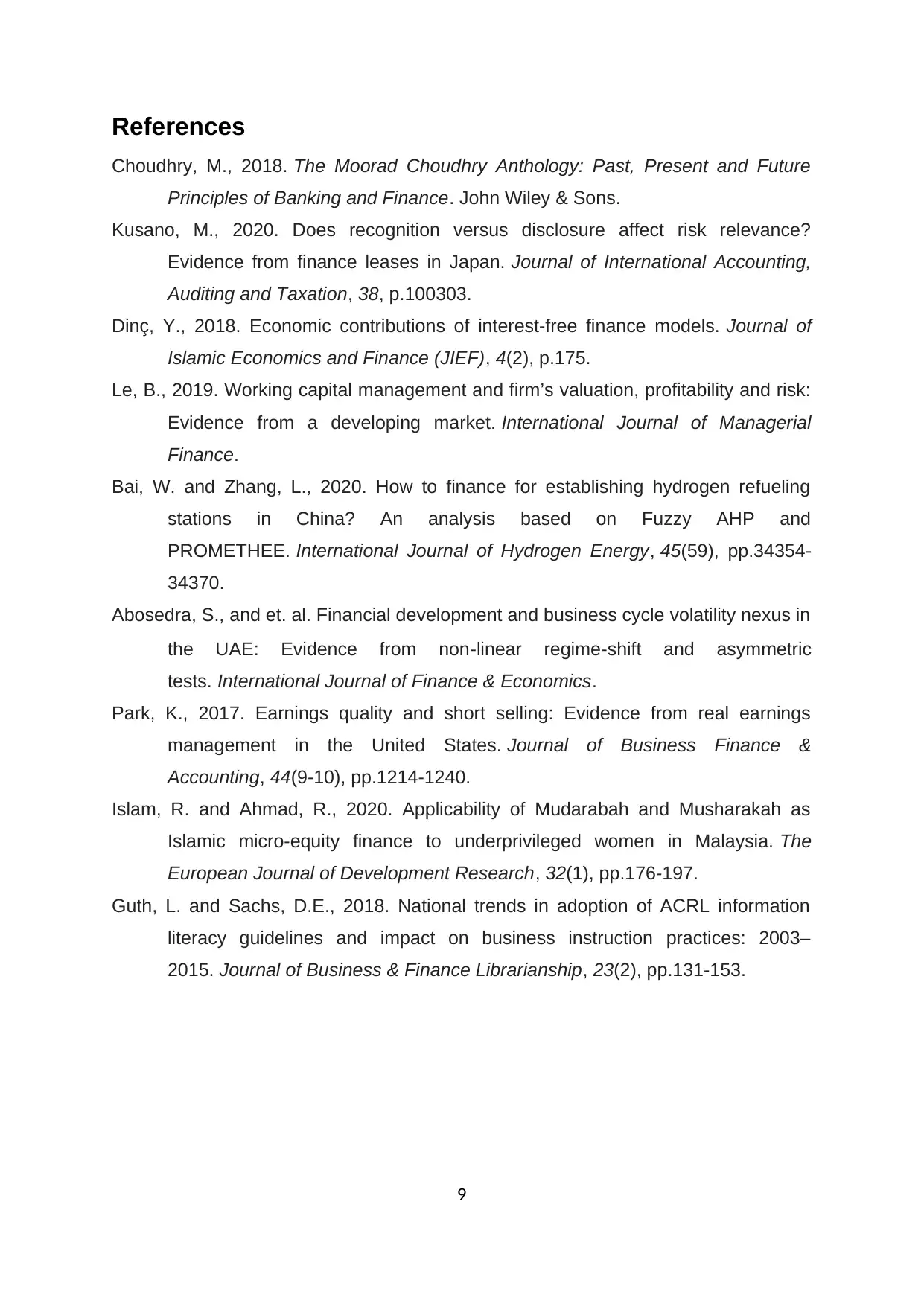
References
Choudhry, M., 2018. The Moorad Choudhry Anthology: Past, Present and Future
Principles of Banking and Finance. John Wiley & Sons.
Kusano, M., 2020. Does recognition versus disclosure affect risk relevance?
Evidence from finance leases in Japan. Journal of International Accounting,
Auditing and Taxation, 38, p.100303.
Dinç, Y., 2018. Economic contributions of interest-free finance models. Journal of
Islamic Economics and Finance (JIEF), 4(2), p.175.
Le, B., 2019. Working capital management and firm’s valuation, profitability and risk:
Evidence from a developing market. International Journal of Managerial
Finance.
Bai, W. and Zhang, L., 2020. How to finance for establishing hydrogen refueling
stations in China? An analysis based on Fuzzy AHP and
PROMETHEE. International Journal of Hydrogen Energy, 45(59), pp.34354-
34370.
Abosedra, S., and et. al. Financial development and business cycle volatility nexus in
the UAE: Evidence from non‐linear regime‐shift and asymmetric
tests. International Journal of Finance & Economics.
Park, K., 2017. Earnings quality and short selling: Evidence from real earnings
management in the United States. Journal of Business Finance &
Accounting, 44(9-10), pp.1214-1240.
Islam, R. and Ahmad, R., 2020. Applicability of Mudarabah and Musharakah as
Islamic micro-equity finance to underprivileged women in Malaysia. The
European Journal of Development Research, 32(1), pp.176-197.
Guth, L. and Sachs, D.E., 2018. National trends in adoption of ACRL information
literacy guidelines and impact on business instruction practices: 2003–
2015. Journal of Business & Finance Librarianship, 23(2), pp.131-153.
9
Choudhry, M., 2018. The Moorad Choudhry Anthology: Past, Present and Future
Principles of Banking and Finance. John Wiley & Sons.
Kusano, M., 2020. Does recognition versus disclosure affect risk relevance?
Evidence from finance leases in Japan. Journal of International Accounting,
Auditing and Taxation, 38, p.100303.
Dinç, Y., 2018. Economic contributions of interest-free finance models. Journal of
Islamic Economics and Finance (JIEF), 4(2), p.175.
Le, B., 2019. Working capital management and firm’s valuation, profitability and risk:
Evidence from a developing market. International Journal of Managerial
Finance.
Bai, W. and Zhang, L., 2020. How to finance for establishing hydrogen refueling
stations in China? An analysis based on Fuzzy AHP and
PROMETHEE. International Journal of Hydrogen Energy, 45(59), pp.34354-
34370.
Abosedra, S., and et. al. Financial development and business cycle volatility nexus in
the UAE: Evidence from non‐linear regime‐shift and asymmetric
tests. International Journal of Finance & Economics.
Park, K., 2017. Earnings quality and short selling: Evidence from real earnings
management in the United States. Journal of Business Finance &
Accounting, 44(9-10), pp.1214-1240.
Islam, R. and Ahmad, R., 2020. Applicability of Mudarabah and Musharakah as
Islamic micro-equity finance to underprivileged women in Malaysia. The
European Journal of Development Research, 32(1), pp.176-197.
Guth, L. and Sachs, D.E., 2018. National trends in adoption of ACRL information
literacy guidelines and impact on business instruction practices: 2003–
2015. Journal of Business & Finance Librarianship, 23(2), pp.131-153.
9
Paraphrase This Document
Need a fresh take? Get an instant paraphrase of this document with our AI Paraphraser
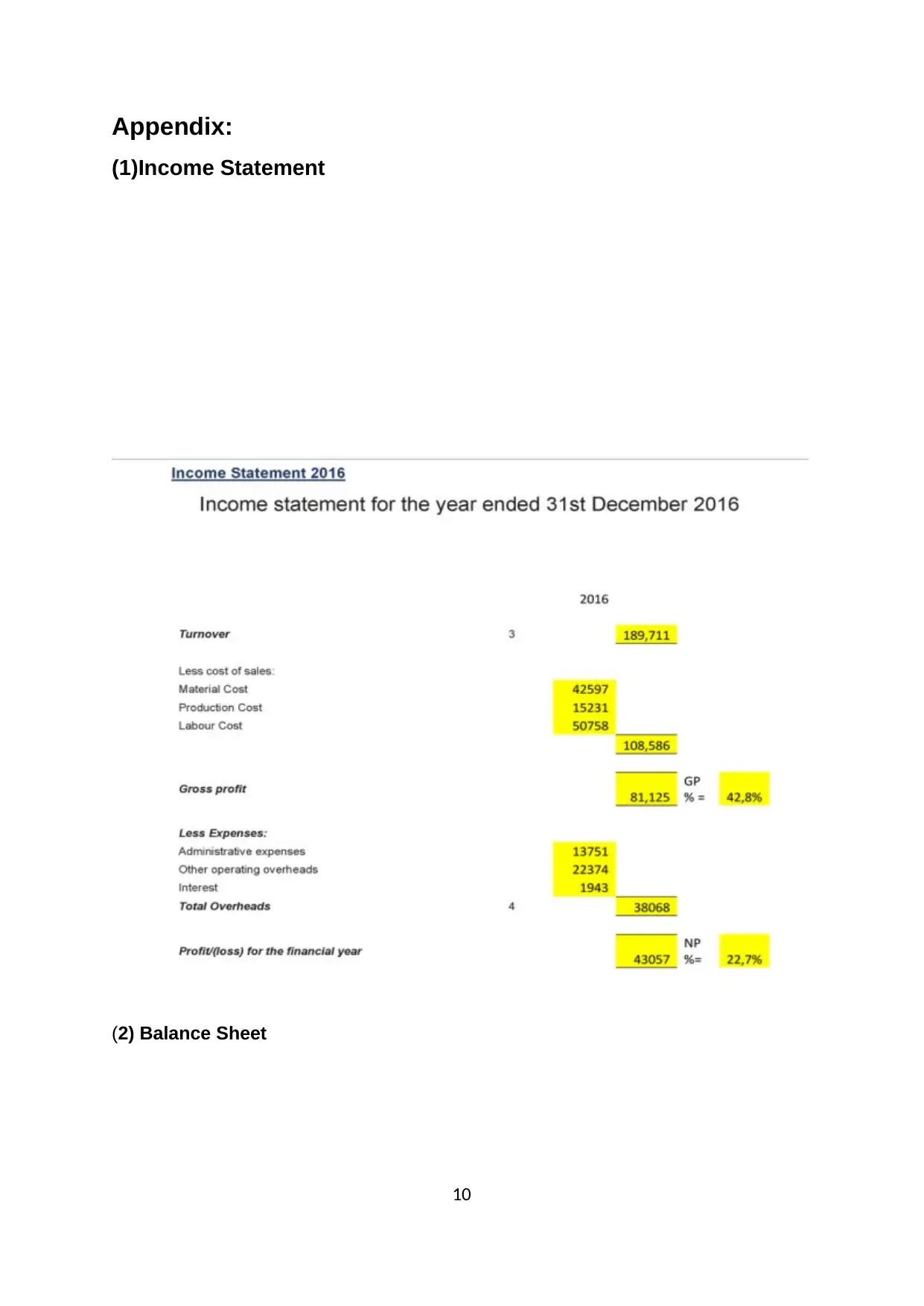
Appendix:
(1)Income Statement
(2) Balance Sheet
10
(1)Income Statement
(2) Balance Sheet
10
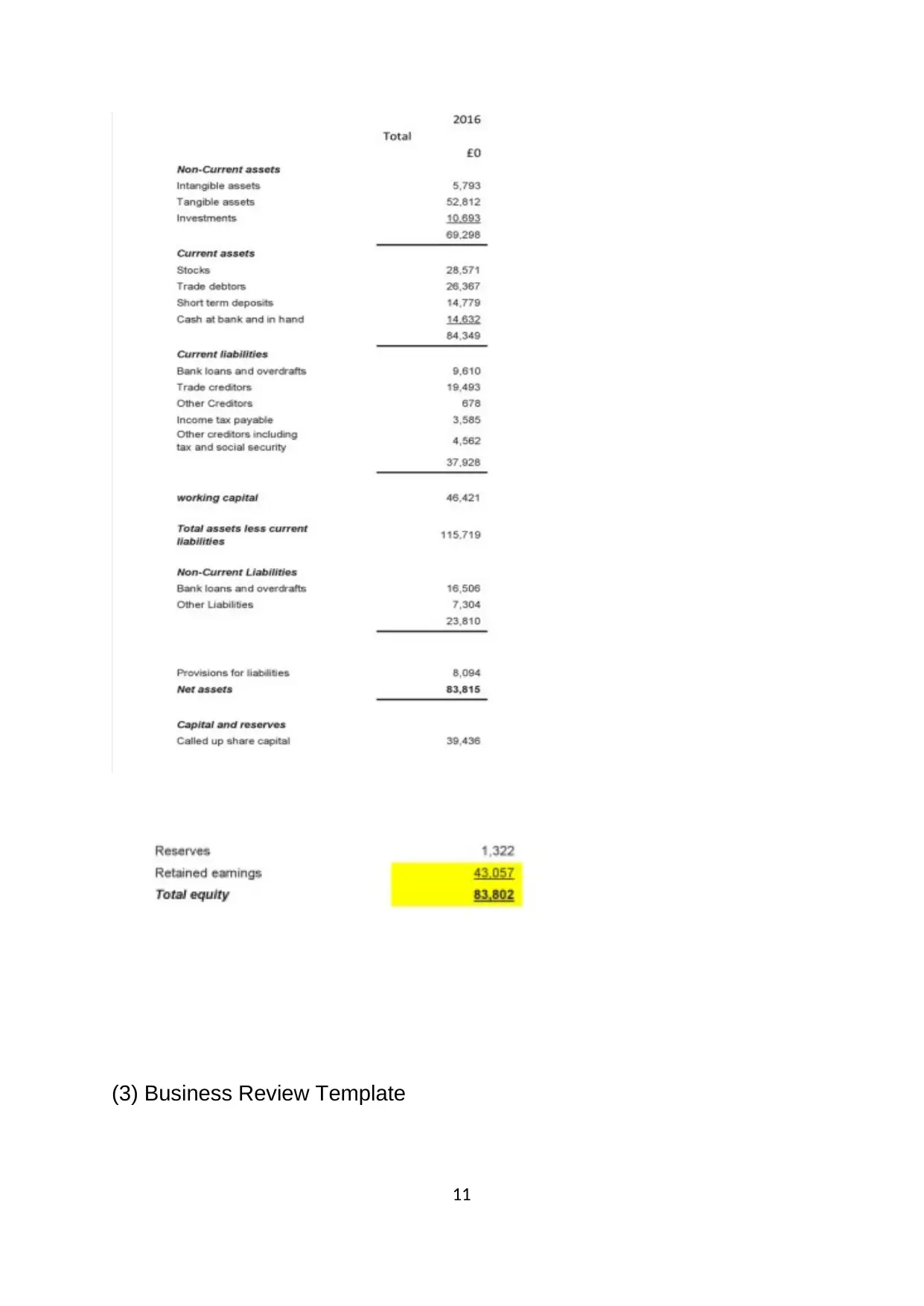
(3) Business Review Template
11
11
⊘ This is a preview!⊘
Do you want full access?
Subscribe today to unlock all pages.

Trusted by 1+ million students worldwide
1 out of 14
Related Documents
Your All-in-One AI-Powered Toolkit for Academic Success.
+13062052269
info@desklib.com
Available 24*7 on WhatsApp / Email
![[object Object]](/_next/static/media/star-bottom.7253800d.svg)
Unlock your academic potential
Copyright © 2020–2025 A2Z Services. All Rights Reserved. Developed and managed by ZUCOL.

